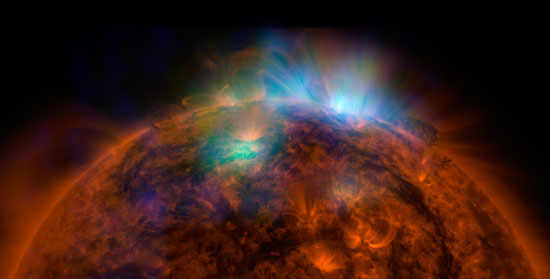NASA’s NuSTAR mission recently returned a striking image that shows the Sun’s active regions crackling with X-rays.

NASA / JPL-Caltech / GSFC
Most telescopes avoid the Sun. Even at wavelengths outside the visible range, the Sun can be exceedingly bright. But NASA’s NuSTAR telescope climbs to high enough energies that it can take on the sungazing challenge — if with a squint.
NuSTAR takes simultaneous images and spectra of the high-energy X-ray sky, capturing radiation between 2 and 80 kiloelectronvolts (keV). Because it targets higher energies than other X-ray imagers, such as NASA’s Chandra or ESA’s XMM-Newton, NuSTAR isn’t blinded by the Sun. The above portrait proves it, capturing the Sun’s image —and spectrum — at energies up to 7 keV.
But NuSTAR can’t gaze at the Sun with eyes wide open either. The space telescope’s bandwidth (the limit to how fast it can transmit information to Earth) is 800 counts per second. The active Sun produces far more X-ray photons than that, even in this unusually quiet solar cycle.
“Only about 1% of what is hitting the detectors is actually getting processed by the data system,” says David Smith (University of California, Santa Cruz), solar physicist and NuSTAR science team member. Observing a quiet Sun, NuSTAR’s efficiency could go as high as 100%, but astronomers may have to wait a few years for that.
(Or not — the science team is ready to snap more solar pictures should some very good luck throw a few quiet days NuSTAR’s way.)
Yet even processing data at 1% efficiency, NuSTAR didn’t turn up empty-handed. Most of the X-rays it caught and transmitted to Earth were between 2 and 5 keV, and they appear to come from active regions where plasma sizzles at 5 million Kelvin (9 million °F).
“What we're seeing in the active regions isn't exactly surprising, but it's still important,” Smith says. The solar corona is already hot at 1 million degrees, so why are active regions even hotter? Is it just more of the same process that heats the rest of the corona, or something altogether different?
More NuSTAR observations will come in the years ahead as the Sun quiets, enabling the team to investigate nanoflares or even look for dark matter particles known as axions. But the team is happy to start analyzing the observations they have in hand now. “We might be able to make progress on these questions with the data we already have,” Smith says.
 0
0
Comments
You must be logged in to post a comment.